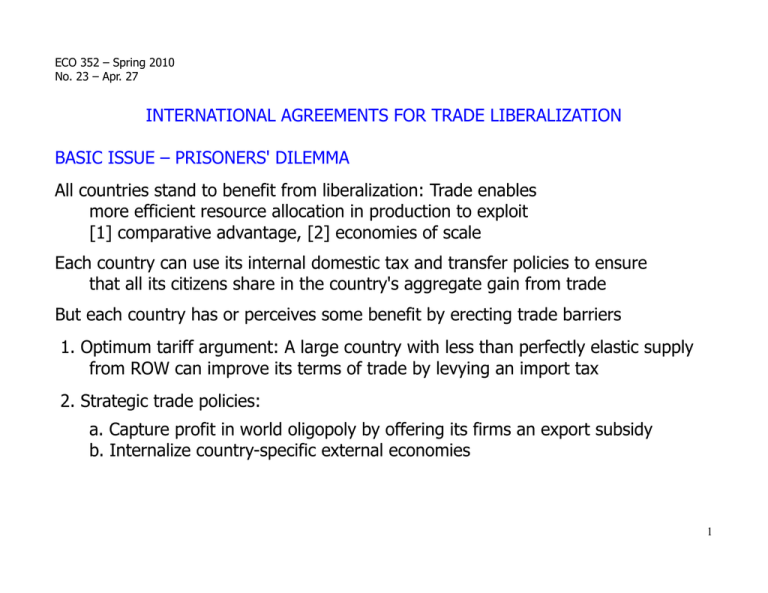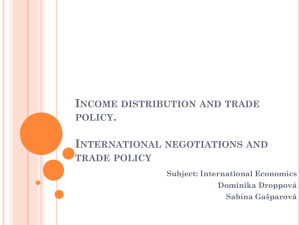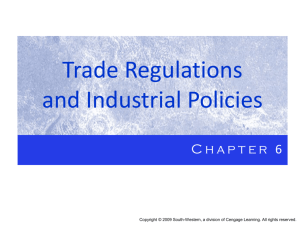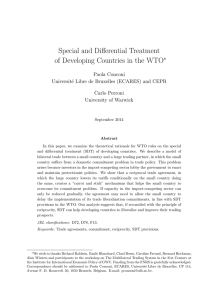INTERNATIONAL AGREEMENTS FOR TRADE LIBERALIZATION BASIC ISSUE – PRISONERS' DILEMMA
advertisement

ECO 352 – Spring 2010 No. 23 – Apr. 27 INTERNATIONAL AGREEMENTS FOR TRADE LIBERALIZATION BASIC ISSUE – PRISONERS' DILEMMA All countries stand to benefit from liberalization: Trade enables more efficient resource allocation in production to exploit [1] comparative advantage, [2] economies of scale Each country can use its internal domestic tax and transfer policies to ensure that all its citizens share in the country's aggregate gain from trade But each country has or perceives some benefit by erecting trade barriers 1. Optimum tariff argument: A large country with less than perfectly elastic supply from ROW can improve its terms of trade by levying an import tax 2. Strategic trade policies: a. Capture profit in world oligopoly by offering its firms an export subsidy b. Internalize country-specific external economies 1 Trade barriers can also be “second-best” policies to serve other purposes [1] to counter various domestic distortions and market failures including externalities, unemployment [2] to serve domestic interest groups for political reasons, or in some cases redistribute income for moral / ethical reasons But when each pursues the selfish strategy, all are hurt So the game of trade policy interaction among countries, when played non-cooperatively, is a Prisoners' Dilemma Cooperative agreements attempt to resolve this dilemma Problem – no or weak enforcement when each country is sovereign Need to make agreements compatible with available enforcement This has implications for [1] nature and functioning of the international organizations governing trade [2] limits on feasible liberalization agreements [3] which countries gain more in the bargaining 2 Behavior in the trade policy prisoners' dilemma (PD) is affected by: Country size Very small countries: Little scope for optimal tariff or strategic trade policy; only second-best and political reasons. But usually have most to gain most from trade. Hence usually favor liberalization; devise internal distributive policies and social safety nets for those hurt by trade. Especially true of small homogeneous states. If a very large country is economically and politically dominant, it “internalizes” the damage caused by the PD; refrains from using power; takes lead in liberalization. Examples: Britain in the late 19th century; US for two decades after WW2. Medium-sized countries are most likely to cheat in the PD; hardest to secure agreement for liberalization; often too large politically to punish after cheating. Breakdown of a hegemonic system is often the worst time for sustaining or improving trade liberalization. Time and patience In bargaining games, patient party gets best deal. US is often at disadvantage Effectiveness of enforcement mechanism Adjudicating and punishing cheating on trade agreements is especially difficult 3 BRIEF HISTORY OF GATT AND WTO Will look at brief history of post-WW2 developments in this light Attempt to form an international trade organization (ITO) together with the IMF and the World Bank did not succeed Substitute GATT emerged, with weak enforcement but conducted several rounds of liberalization with mixed success WTO was established in 1995 with somewhat stronger rules, enforcement Coexists with several “preferential arrangements” among groups of countries Two aspects of GATT/WTO: [1] Negotiations for trade liberalization in successive “rounds” [2] Enforcement of agreements and dispute settlement mechanism (DSM) Underlying principles: [1] “Most-favored-nation” (MFN) principle: treat all other countries the same [2] Transparency or “domestic treatment”: no further discrimination against imports after agreed & known barriers crossed Sometimes more honoured in the breach than in the observance 4 Participating countries' attitudes and strategies Mercantilism: The belief that international trade is a zero-sum game The idea is to win production at the expense of other countries Erecting barriers to imports and promoting exports for this purpose Modified mercantilism; Krugman's “GATT-think” [1] exports are good, [2] imports are bad, [3] an equal expansion of exports and imports is on balance good So each country “concedes” or agrees to accept more imports in return for other countries' reciprocal acceptance of its exports Economists' perspective: benefit of trade arises from the opportunity to obtain imports at lower cost than home production Therefore a country should lower its barriers to imports for its own benefit, not as a concession to others. (Except for optimal tariff, second best etc) Rationalization? The “concession” attitude can be a useful ploy in negotiations Country A benefits when B lowers its barriers to A's exports (A's TOT improve) B can extract some of this gain for itself by threatening not to liberalize unless A liberalizes its imports to improve B's terms of trade. And vice-versa. A and B may not have enough bilateral trade, or not large enough for TOT change So this issue is more important in context of multiple countries, blocs 5 Successive “rounds” of GATT / WTO negotiations Name Start Duration Countries Geneva 1947 7 months 23 Tariffs Achievements Signing of GATT treaty, 45,000 tariff concessions affecting $10 billion of trade Annecy 1949 5 months 13 Tariffs 5,000 tariff concessions Torquay 1950 8 months 38 Tariffs 8,700 tariff concessions, cutting the 1948 tariff levels by 25% Geneva 2 1956 5 months 26 Tariffs $2.5 billion in tariff reductions Dillon 1960 11 months 26 Tariffs Tariff concessions worth $4.9 billion of world trade Kennedy 1964 37 months 62 Tariffs, Anti-dumping Tariff concessions worth $40 billion of world trade Tokyo 1973 74 months 102 Tariffs, NTBs, framework agreements Tariff reductions worth more than $300 billion dollars Uruguay 1986 87 months 123 Doha 2001 ? 141 Subjects covered Tariffs, NTBs, services, intellectual property, dispute settlement, textiles, agriculture, creation of WTO, ... Tariffs, NTBs, agriculture, labor standards, environment, competition, investment, transparency, patents ... achieved The round led to the creation of WTO, and extended the range of trade negotiations, leading to major reductions in tariffs (about 40%) and agricultural subsidies, an agreement to phase out the MFA for textiles and clothing, and an extension of intellectual property rights enforcement. The round is in a state of impasse. Details below. Souce: Wikipedia Tariffs were high after the 1930s, and early rounds focused on them Countries started to “cheat” by using various non-tariff barriers (NTBs) instead Later rounds have tried to reduce them; that has proved harder Realization: Perhaps allowing (low) tariffs not so bad – “tariffication” idea 6 THE DOHA ROUND Launched as “Doha Development Agenda,” to give special attention to needs of LDCs Negotiations broke down in Cancun 2003 Revived in Hong Kong 2004-5, stopped again in 2006 ... Central Issues: Developed country policies that hurt developing countries Barriers to imports of agriculture and non-agricultural labor-intensive exports EU, US etc. subsidies in agriculture Developing country protection in all sectors, including services In Cancun, Group of 20 (+ or −) Developing Countries rejected draft proposed by US and EU, because it: [1] gave too little on agriculture [2] asked too much from developing countries, including 4 “Singapore Issues” transparency in government procurement, trade facilitation (customs issues), trade and investment, and trade and competition. The developed countries later backed down on many of these issues, but the failure of EU, US to make firm and credible commitments on agriculture remains a problem, and on past experience LDCs fears are justified 7 Developing countries are not united: Many smaller countries fear competition with China and India This fear is overblown; they have comparative advantage in other things Some LDCs face erosion of preferences from specific advanced countries or regions This fear is real and not avoidable But LDCs will not achieve their common aims unless they are united Other possibilities: [1] Regional or other preferential trade agreements among LDCs as well as with subsets of advanced countries Many of the latter are being actively pursued [2] Agreements in sub-sectors / industries [3] Unilateral liberalization where their own policies are sufficiently damaging Risks: [1] LDCs stand to gain most from success of Doha round [2] Regional / preferential agreements may make broader agreement harder (But may also be stepping-stones to such agreement in the future) 8 DISPUTE SETTLEMENT MECHANISMS GATT rules and procedures were weak and ineffective Country A could complain that country B was violating a GATT rule GATT would convene a panel that would produce a report It would have to be approved unanimously by GATT members So if complaint was upheld, B would have to vote to hold itself guilty! Surprisingly, this sometimes happened. The report would allow A to impose specified duties on imports from B But A might not be importing much of significance from B Need to have other countries sanction B on A's behalf – problematic In WTO, a panel report becomes effective unless unanimously vetoed by members A right to appeal is also added. Coverage expanded beyond goods to some services, intellectual property, agriculture ... But problem of “double-coincidence” remains And recourse against defiance by a large country may be limited Remaining questions: [1] Interaction with other issues like labor standards, human rights, environment [2] Interaction with regional and similar preferential trade agreements 9 WHY MFN? In the process of negotiations, if country A offers a “concession” to country B, it is required to offer the same to all members If this were not required, B would be reluctant to agree, fearing that C, D … could get better deals from A later Sole exception in principle: a free trade area A group of countries is allowed to agree a better deal among themselves But this has to be “substantially” total liberalization Related issue of credibility in negotiation: A liberalization agreement is a treaty requiring ratification by each country's legislature, and some incorporation in domestic laws Parliamentary democracies or more authoritarian regimes can do this easily But in US the Congress has power, and may try to pick apart a deal, ratifying only the parts it favors and demanding renegotiation of the rest Other countries fearing this would be reluctant to deal with the US, unless the negotiators came with “fast track authority”, whereby the Congress commits itself to an up-or-down vote without amendments 10 A MODEL OF FEASIBLE LIBERALIZATION When will a country abide by an agreed low tariff? U(T, t) = country's “utility” when its tariff rate is T and that of others is t Could be social welfare or a political objective, so model can be about econ or pol. n n Single-period Nash equilibrium: Rate t such that U(T,t ) is maxed by setting T = t If agreed rate is t, country's benefit from cheating is B(t) = max T n U(T,t) – U(t,t) n By definition of Nash equilibrium, B(t ) = 0, and B(t) > 0 elsewhere Suppose cheating would lead to collapse of agreement, followed reversion to single-period Nash in the future, n n so cost of cheating is capitalized value C(t) = [ U(t,t) – U(t ,t ) ] / r Assume symmetrically low tariffs are good for everyone, so C(t) is a decreasing function. n Also C(t ) = 0, and since the dead-weight losses from a small tariff are second-order C´(0) = 0 11 Figure shows the benefit and cost of typical cheating functions If r is very low (very patient countries), we can have C(0) > B(0) and full free trade may be sustainable But for politically realistic values of r, we will have C(0) < B(0) The t* where they cross is the smallest common tariff rate that is a feasible outcome of liberalization “Don't let the best be the enemy of the good” Practical negotiators understand this better than many academics! 12






